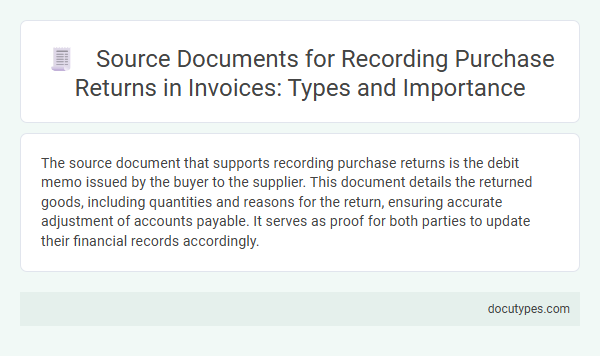The source document that supports recording purchase returns is the debit memo issued by the buyer to the supplier. This document details the returned goods, including quantities and reasons for the return, ensuring accurate adjustment of accounts payable. It serves as proof for both parties to update their financial records accordingly.
Introduction to Source Documents in Purchase Returns
Source documents are essential in accurately recording purchase returns, serving as evidence for transactions. They provide detailed information critical for maintaining accurate financial records and ensuring proper documentation of goods returned to suppliers.
- Credit Note - A credit note is issued by the supplier to confirm the return of goods and adjust account balances accordingly.
- Purchase Return Invoice - This document details the returned items, quantities, and reasons for the return, supporting accurate ledger entries.
- Delivery Challan - Used to document the physical movement of returned goods from the buyer back to the supplier.
Using these source documents ensures transparency and accuracy in the recording process of purchase returns.
Definition and Role of Purchase Returns in Invoicing
Purchase returns refer to the process where a buyer returns goods to the supplier due to defects, damages, or discrepancies. This transaction directly impacts the accounts payable and inventory records in invoicing systems.
The source document that supports recording purchase returns is the Purchase Return Note or Debit Note. It serves as official proof of goods returned, ensuring accurate adjustment in financial and inventory records.
Key Types of Source Documents for Purchase Returns
What source document supports recording purchase returns? A debit memo is the primary document used to record purchase returns as it details the returned goods and the reduction in the amount owed to the supplier. You should also keep the original purchase invoice and return authorization form for accurate record-keeping.
Credit Note: Meaning and Application
A credit note is the primary source document that supports recording purchase returns. It serves as official proof from the supplier acknowledging the return of goods and the reduction in the amount owed.
This document details the items returned, their quantities, and the adjusted amounts. You use the credit note to accurately update your purchase records and ensure your accounts reflect the return.
Debit Note: Purpose and Usage in Purchase Returns
The primary source document that supports recording purchase returns is the debit note. A debit note is issued by the buyer to the supplier, indicating the return of goods and requesting a reduction in the amount payable.
Debit notes serve as formal records that adjust the supplier's invoice amount by accounting for returned items. They provide clear evidence for both parties to update their financial records accurately. Using debit notes ensures transparency and proper documentation in the purchase return process.
Purchase Return Journal: Structure and Function
The purchase return journal serves as the primary source document supporting the recording of purchase returns in accounting. Your accurate entries in this journal ensure proper tracking and management of returned goods.
The structure of the purchase return journal includes key elements such as date, supplier name, invoice number, return quantity, and amount. Its function is to systematically record all purchase returns, facilitating clear financial reporting and inventory control.
- Date Column - Records the exact date when the purchase return transaction occurred.
- Supplier Name - Identifies the vendor from whom goods were returned.
- Return Amount - Displays the monetary value of the goods returned to the supplier.
Importance of Accurate Documentation in Purchase Returns
The source document that supports recording purchase returns is the purchase return slip or debit note, which provides detailed information about the returned goods and reasons for the return. Accurate documentation in purchase returns is crucial for maintaining precise inventory records and ensuring proper adjustments in accounts payable. You rely on these documents to verify transactions and prevent discrepancies in financial statements.
Common Errors in Recording Purchase Returns
The source document that supports recording purchase returns is the purchase return note or credit memo issued by the supplier. Common errors in recording purchase returns include failing to update inventory records accurately, recording the return in the wrong accounting period, and misclassifying the return as a purchase instead of a return. Ensuring accurate documentation and timely entry helps maintain precise financial statements and inventory control.
Best Practices for Managing Source Documents
| Source Document | Credit Memo |
|---|---|
| Description | Credit memos are issued by vendors to confirm returned goods and adjust the amount owed on the original invoice. |
| Purpose | Supports accurate recording of purchase returns by providing evidence of the transaction reversal. |
| Best Practices for Managing Source Documents |
|
| Key Data Points to Capture |
|
What Source Document Supports Recording Purchase Returns? Infographic

